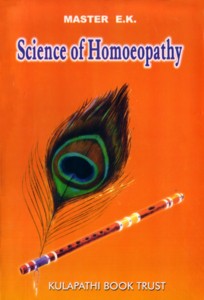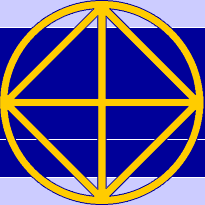Book Presentation
"The Science of Homoepathy"
by Dr. Ekkirala Krishnamacharya

This small booklet contains the teaching notes that Master EK has used during the years. He had
a rich experience of practising and teaching Homoeopathy. The definitions of health, symptoms, acute and chronic
diseases and their treatment, as well as the study of the basic principles of Homoeopathy are all given in a
clear and impressive manner.
This book is not only interesting for homoeopaths, who
find here far-reaching insights, but also for the layman who wants to understand the wisdom underlying
homoeopathy.
Contents: Health; Acute Diseases and their Treatment; Chronic Diseases
and their Treatment; Doctor, the Healer; Dilution & Potency; Something about Symptoms; To find out if the
Treatment is going right; Chronic Diseases; The Special features of Chronic Disease Treatment; Lecture 1
(Friday, Sept. 23rd, 1983): Health & Disease; Lecture 2 (Saturday Sept. 24th, 1983): The four-way check;
Remembering Remedies; A New Dimension to Science; Law of Polarities; Classification of Drugs; Stage of
Curability and Incurability.
Kulapati Book Trust Visakhapatnam, India, 2000-2.
- Book order information
- About the Author
- We have a few English copies to distribute for free.
Sample:
Chapter 3. Chronic Diseases and their TreatmentDiseases are of two types, acute and chronic. Something has been described about acute diseases. Chronic diseases are understood as those that take a prolonged period of time, that cause many complications in the course of their treatment and those that are difficult to be cured. This is the popular opinion about chronic diseases. Even the practitioners of the popular systems of medicine have the same opinion. When acute diseases like pneumonia and bronchitis go into complications, being wrongly treated, take a long period and cause many complications. The practitioners are busy in dumping very powerful medicines, calling them chronic diseases after a few weeks. Even the medicines that are repeated for a prolonged period in such cases produce their own diseases to add to the existing complications. The original acute disease gets mixed up with the subsequent complications and cannot be traced independently. All such cases can be called "false chronic diseases".
Apart from these, there are “real chronic diseases” which show their own characteristics. They show only two stages, the prodrome and the progress. The culmination never includes a natural cure since the disease invariably kills the patient unless medicated properly and timely. Acute diseases get cured within a short period whereas real chronic diseases kill the patient after a prolonged period of time. The prodrome or incubation is rather slow and takes a very long time. The progress of a chronic disease is also too slow to be taken proper care of. The symptoms and the sufferings are rather passive and slowly developing. They are never violent until it is too late. Disease runs undercurrent without making a striking manifestation. The disease exists with the constitution secretly and makes the person frequently susceptible to all sorts of acute diseases. Any day during the progress they do not precipitate a crisis enough to be taken care of. Towards the culmination they take the shape of an incurable disease that attacks some parts of the body, brings violent tissue changes that cannot be cured and the patient meets his end very painfully. Tuberculosis, liver diseases, lung diseases, heart diseases, ulcers, cysts and internal outgrowths as well as glandular diseases are some of the culminations of a real chronic disease. Diseases like cancer, hydrothorax, diabetes, carbuncles, gangrene and paralysis are some examples of the culmination of any chronic disease. Unfortunately, these culminations are understood as independent diseases and treated with all the strength of the medicines without any result. The patient is never cured at this stage and he is sure to die as a patient.
Real chronic diseases should be understood and treated in the quite early stages. In the beginning, when they are curable, they, exist as part of the behaviour of the person. They never influence any part or organ of the body. They descend to the physical tissues in course of prolonged time and spoil the constitution. According to the organ attacked, the unwise doctor names it as the disease of that organ. He concentrates to treat that organ. Such a treatment can do nothing but palliation and palliation is no cure. Also palliation proves useless in course of time. Palliation conceals the real condition of the patient, while the disease advances secretly. The strong medicines that are repeatedly used produce their own diseases that affect some other organ. Thus, the disease and the medication greet the patient at the grave. Names of diseases are multiplied by the area affected by the disease. So, we have hundreds of new diseases discovered every year. If the disease runs under-current for a time and attacks the heart, he is called a cardiac patient. If it is liver, he is a liver-patient, and so on. These names are understood as diseases. So, we hear about the digestive troubles, intestinal troubles, gynic troubles, uterinary troubles, bone diseases, urinary diseases, kidney troubles and so on. We also hear about eye diseases, ear diseases, nose and throat diseases, mental diseases etc. It is our duty to set these names aside and understand the undercurrent chronic diseases with a really scientific approach. It provides us with such an approach.
Accordingly there are only three real chronic diseases that stand to observation and practical procedure to cure. They never occur in any part of the body. We have to understand their existence with the help of the peculiarities of the behaviour of a patient and treat them early. Since these real chronic diseases form part of the behaviour and since behaviour forms part of the person, you have to direct the treatment towards the person and not at all towards the disease. You have to select a medicine to rectify the behaviour of the patient rather than to cure a supposed disease in some part of his body. For example, if you direct your treatment towards the sugar in urine of a diabetes patient, you can never succeed. It is the patient who is to be treated and not the sugar or urine. Practitioners offer a daily fight with the urine of their patient, to accept defeat in the end. To have real success, one should have a different approach. He should observe the peculiarities in the behaviour of his patient. Situations when he is angry, suspicious. jealous, etc., should be studied. His food, sleep and rest should be carefully observed. The abnormalities of his behaviour and habits should be recorded and understood as his symptoms. The totality of symptoms should be constructed with them. A remedy that bears similarity with this totality of symptoms should be well selected and administered. His disease (the totality of his abnormalities) will be cured and with it, the sugar in urine disappears. We will take some examples.
1. One patient having sugar in urine suffers from internal heat, anguish, short-breath, puffiness and suffocated feeling. He has also smarting and pin-prick sensation in his feet and hands. The face and eyes are puffy and swollen, the feet show oedema, the eyes are red and watery. The eyes bum and eyelids are itching. He has much thirst and feels very happy with the application of cold water. This is the required information to cure him (not the sugar in urine). The totality of his sensations, feelings and behaviour indicates similarity with the remedy Apis Mellitus which, when administered, will cure his totality. Along with it, the sugar in urine disappears. …

 Circle of Good Will
Circle of Good Will Contact
Contact
